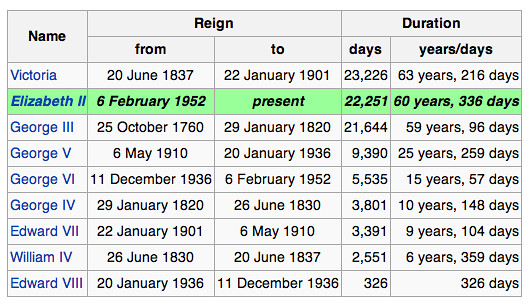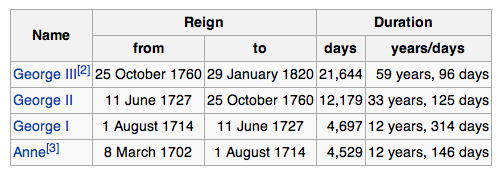George II and the Gregorian calendar
January 7, 2013 at 10:13 PM by Dr. Drang
Did you see this Jason Kottke post today? The main link is to a site with photos of Queen Elizabeth with twelve US presidents—ten of the eleven who’ve been in office since the start of her reign (LBJ is missing), plus Harry Truman and Herbert Hoover. But the link that interested me the most was to this Wikipedia page listing the longest-reigning British monarchs.
QE II is currently in second place to Victoria, having passed George III (America’s favorite) over a year and a half ago. The tables on the page give the durations of the reigns in both days and years/days.
The former is a reasonably precise measure, but the latter isn’t because different years don’t have the same number of days. There is, of course, the 366/365 variation between leap years and “regular” years, but there’s also the very funky year of 1752, which had 355 days. That’s how many days there were in England, anyway. Italy had the normal complement of 366 days. God only knows how many Sweden had.
The differences are due to the uneven adoption of the Gregorian calendar. Catholic countries began adopting it shortly after Pope Gregory XIII reformed1 the calendar in 1582. Protestant countries, no doubt suspecting a popish plot of some sort, stuck to the Julian calendar until good sense prevailed. It wouldn’t be right to have the first day of spring in February, and that’s where things were heading.
When England finally got around to going Gregorian, it was eleven days behind, so it chopped those extra days out of September to put it in sync.2 People went to bed on the night of September 2 and woke up on the morning of September 14. We’ve all had nights like that.
So what does this have to do with British monarchs? Well, George II took the throne on June 11, 1727 and died on October 25, 1760, so his reign spanned the Gregorian changeover. When I saw the table with his reign’s duration in it, I couldn’t help but wonder if the duration in days had been calculated correctly.
Python’s datetime module doesn’t have routines for converting between Julian and Gregorian, but we don’t really need that. All we need to do is calculate the number of days from June 11, 1727 to October 25, 1760 in the Gregorian calendar and then subtract 11. Here’s my IPython session
In [1]: from datetime import date
In [2]: start = date(1727,6,11)
In [3]: end = date(1760,10,25)
In [4]: end - start
Out[4]: datetime.timedelta(12190)
An all-Gregorian calculation gives a reign of 12,190 days. Therefore, Wikipedia has it right with 12,179 days. Nicely done.
As always when I blog about calendars, I’m going to recommend Dershowitz and Reingold’s wonderful Calendrical Calculations, which explains—via text and Lisp code—how ten or so calendars work. Yes, the Mayan calendar is included, so you can look into what all that fuss was about.
Also, one of my favorite Unix things is the way the cal command handles the Gregorian reform. Since the US was a British colony when the changeover occurred and Unix was initially written by Americans, cal uses British dates. Type
cal 9 1752
at the command line for a delightful Easter egg.
-
“Reform” was a touchy word for the Catholic Church in the 16th century, but as far as I know Luther had no interest in calendars. ↩
-
According to Wikipedia, Sweden decided to go from Julian to Gregorian gradually over the course of 40 years by simply not having leap years, but it forgot a couple of times and then there was that year with a February 30… ↩



